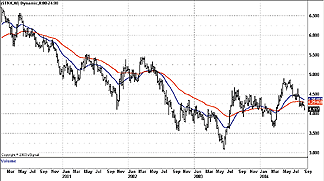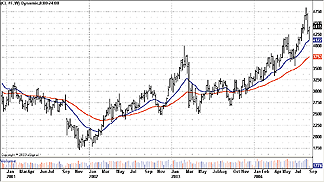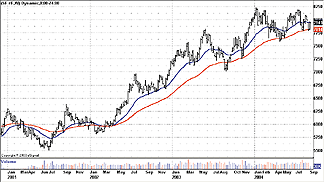How do you spell "inflation"? O-I-L? How about long-term interest rates, such as those attached to the 10-year US Treasury note? If you are a supply-side economist of the Jude Wanniski school, then maybe you will refuse to shout "inflation" until you see the color of the eyes of the "POG," more familiarly known as the price of gold. Then again, if you believe that an inflating dollar has to have another currency against which to depreciate in value, how about the Swiss franc, that stalwart European currency of the inflationary 1970s?
With the Federal Reserve Board's stance on the economy somewhat mixed (here's a hint: "soft patch" means "resurgent fears of deflation"), investors and traders need more help than ever in determining just what an inflationary environment -- or rather, the first stages of an inflationary environment -- might look like. To that end, Intermarket Review profiles the top four compasses of market-oriented inflationary expectation: the price of gold, the yield on the 10-year T-note, crude oil, and the Swiss franc.
GOLD

What can be said about gold? "The only real money ..."? "Barbaric relic ..."? Federal Reserve Board chairman Alan Greenspan, arguably the greatest financial asset inflationist in American history, once wrote of gold: "This is the shabby secret of the welfare statists' tirades against gold. Deficit spending is simply a scheme for the confiscation of wealth. Gold stands in the way of this insidious process. It stands as a protector of property rights ..." Cryptologists need not apply, there was no modern-day Fed-speak there. It is worth adding that in addition to gold's role as a monetary indicator (rising gold prices reflect inflationary fears, falling gold prices reflect deflationary or disinflationary fears), gold has a number of uses in both technology and industry, as well as, of course, in jewelry.
Gold's rally since its bottom in early 2001 has been a fairly steady ride ever since. Gold experienced a blow-off top late in 2002 (a few months before the blow-off top in crude oil, by the way), which turned out to be little more than a buying opportunity for the yellow metal's next ride up. In the wake of that top, gold has rallied as high as $425 in late 2003 and, even in its 2004 correction, has remained quite close to a $400 level that would have had gold bugs drooling only a few years back.
What they said: "First, India, the world's biggest gold importer, was unfalteringly a buyer right up to the high of $412 this past week. I gauge Indian off-take by looking at the local premiums. Previously, Indian buying has been choked off at these levels. And the busy season for gold purchases in India is only just beginning. Inevitable outcome: A great deal of metal will go to live in India this fall -- unless world gold moves up sharply from the $400-plus level." -- John Brimelow, "Never Mind Gold's Price, Look At Volume," CBS Marketwatch.com, August 30, 2004.
10-YEAR US TREASURY NOTE YIELDS

No longer standing in the shadows of the 30-year US Treasury bond, the 10-year US Treasury note has become in recent years the benchmark Treasury security. As such, the coupon, or yield on the T-note, has also become the standard reference for long-term interest rates -- including mortgage rates. Treasury notes often make up a significant part of many safe money market accounts (along with agency notes), futures and options on Treasury notes are widely traded, and options on the coupon (referred to as the TNX) are also exchange-tradable.
The bear market in long-term interest rates is among the "league of extraordinary gentlemen" contributing to the secular bull market in financial assets that dominated finance over the past few decades. Thus, it was with some consternation and anxiety that market commentators have reflected upon the possibility that the $TNX lows of the summer of 2003 represented the bottom in a long, secular slog against a broad-based, rising interest rate economic environment. While softer in recent months, the $TNX's pattern of higher lows and higher highs since that summer continues to intimate higher yields in the months to come.
What they said: "A Democratic win would be... bullish for bonds versus stocks because there would be deficit hawks [calling for] increasing taxes on the affluent. Conversely, the Republican Party wants to make tax cuts permanent for the affluent... . Everything else being equal -- and it never is, of course -- a Republican win is bullish for stocks versus bonds." - Paul McCulley, "Seeing Fed," an interview with Barron's, August 16, 2004.
CRUDE OIL

As the New York Mercantile Exchange notes, crude oil is among the most actively traded commodities in the world. This should be of little surprise, given that oil has been widely regarded as the lubricant of the modern industrial economy. And given the rapid industrialization of nations like China, it is little surprise that crude oil has once again come to dominate the headlines. Crude, or "light sweet crude," to be more specific, is a highly prized commodity among industrialists for a variety of reasons, but especially because so many valuable petroleum products such as gasoline, heating oil, and fuel for jets and diesel engines are derived from it.
The current bull market in crude oil has its origins in the "war rally" that developed in the fourth quarter of 2001 in the major stock averages. At the time, basis continuous futures, crude oil was trading below $20 a barrel. Such prices, however, proved to be the lows as crude oil prices doubled in a year, culminating in the blow-off top in January 2003 as a US-led invasion of Iraq became increasingly likely. Save for a sizable correction in the first half of 2003, the bull market in crude oil never truly relented as, within a year, crude oil prices were soaring toward pre-Iraq invasion levels. As the fourth quarter of 2004 approached, crude oil traders were increasingly sentimental about those "unsustainable" crude oil price extremes from a year and a half ago.
What they said: "With price soaring as much as 50% this year and nearly hitting $50 a barrel last week, oil titans from Texas to Tehran are awash in record revenue. But as the money floods in, they are spending little extra in finding and extracting more petroleum. Essentially, that's because what's good for the world economy -- ample spare capacity -- carries big risks for Western oil majors and OPEC, which have been burned by past supply gluts." -- Bhushan Bahree and Patrick Barta, "Awash In A Gusher Of Cash, Oil Firms Are Reluctant Investors," The Wall Street Journal, August 26, 2004.
SWISS FRANC

If you don't think the Swiss franc hasn't been an inflation hedge whenever the "I" word has popped up in financial discourse, then think again. Although not linked to gold, and thus not a true hard currency, the stability, independence, and "unusually high reputation" of the Swiss banking system is such that the Swiss franc has been prized by those looking to insulate their capital from the vagaries of less responsible central bank stewards. As Cornelius Luca observes in his Trading In The Global Currency Markets: "The Swiss franc is the only currency of a major European country that belongs neither to the European Monetary Union nor to the G-7 countries. This position is, however, typical of Switzerland, a country known for its neutrality."
Luca makes another point worth noting: "Typically, it is believed that the Swiss franc is a stable currency. From a foreign exchange point of view, this is simply not true. The Swiss franc closely resembles the patterns of the euro, but lacks its liquidity. As the demand for it exceeds supply, swissy can be more volatile than the euro."
The Swiss franc finds itself late in a bull market that began in the lows of early 2001. The swissy began making higher highs and higher lows on the weekly chart by the first few days of 2002 and, by mid-year, was clearly in an uptrend. The ride up has been volatile in the Swiss franc, with sharp corrections becoming more and more frequent in the first half and summer of 2003. With its rally in summer 2004, the Swiss franc may have made its first significant lower high.
What they said: "The dollar posted significant gains particularly versus the European currencies as oil prices finally succumbed. For as long as no new crises emerge, the oil prices should consolidate. This week will be a tough one for the FX markets as the Republican National Convention stirred high political passions and triggered a massive security effort in New York. For as long as demonstrators keep their grievances within the limits of the law, the dollar should attempt to add to its gains, despite short-term overbought condition." -- Cornelius Luca, "Weekly Forex Market Commentary," Global Forex Trading at https://www.gftforex.com, August 30, 2004.
Originally published in the December 2004 issue of Technical Analysis of STOCKS & COMMODITIES magazine. All rights reserved. © Copyright 2004, Technical Analysis, Inc.
Return to December 2004 Contents